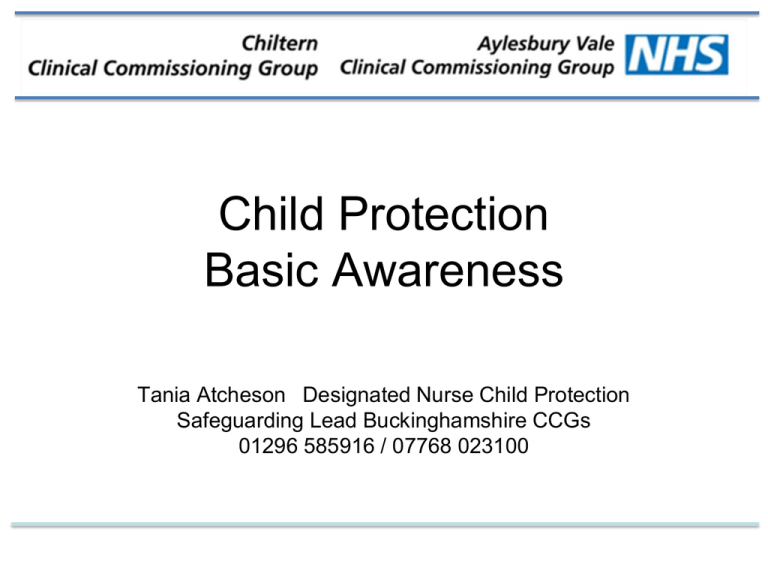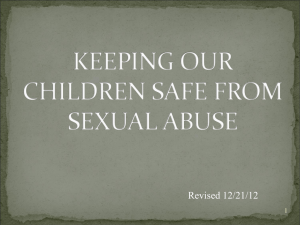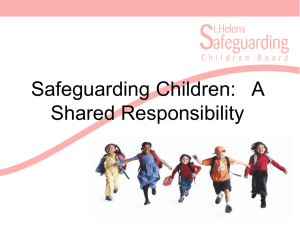
Child Protection
Basic Awareness
Tania Atcheson Designated Nurse Child Protection
Safeguarding Lead Buckinghamshire CCGs
01296 585916 / 07768 023100
GMC Principles
•
•
•
•
•
•
All children have a right to be protected from abuse and neglect
All doctors must consider the needs and well-being of children
Children are individuals with rights
Children have a right to be involved in their own care
Decisions made about children must be made in their best interests
Children and their families have a right to receive confidential
medical care and advice
• Decisions about child protection are best made with others
• Doctors must be competent and work within their competence to
deal with child protection issues
What do you need to know?
•
•
•
•
What is child abuse and neglect?
Signs and indicators of abuse and neglect
What to do in response to concerns
Maintain a child focus – work in partnership
•
•
•
•
Normal Child Development
Impact of abuse and neglect
Factors associated with child maltreatment
Documentation and sharing information
Why is safeguarding necessary in
General Practice?
It is unusual for children and young people not to be registered with a
GP Practice
The surgery are often the first point of contact for health problems
Practice staff are often the first to recognise parental / carer health
problems
Long term effects of abuse include psychological, emotional and social
problems will present in General Practice
Working Together
‘Ultimately,
effective safeguarding of
children can only be achieved by putting
children at the centre of the system, and by
every individual and agency playing their
full part, working together to meet the
needs of our most vulnerable children. ’
WTSC 2013
Statutory guidance
Responsibilities are clearly set out
• Children Act 1989
• Children Act 2004
• Working Together 2013
Department of Education website www.education.gov.uk
Other resources
• Protecting children and Young people:
The Responsibilities of all doctors
GMC July 2012
http://www.gmc-uk.org/guidance/ethical_guidance/13257.asp
• Safeguarding Children &Young People:
A Toolkit for General Practice
RCGP 2011
http://www.rcgp.org.uk/clinical-and-research/clinical-resources/child-and-adolescenthealth/safeguarding-children-toolkit.aspx
• NICE clinical guideline 89 – When to suspect child maltreatment
http://www.nice.org.uk/nicemedia/pdf/CG89NICEGuideline.pdf
The role of the LSCB Local Safeguarding Children Board
The LSCB is the key statutory mechanism for agreeing how the
relevant organisations in each local area will co-operate to
safeguard and promote the welfare of children in that locality, and
for ensuring the effectiveness of what they do
Buckinghamshire LSCB
www.bucks-lscb.org.uk
Looked After Children
LEVELS OF NEED
LAC/
CHILD
PROTECTION
Children in
Care
S47
CHILDREN IN NEED
S17
Children & families needing
Intensive assistance
VULNERABLE CHILDREN
Early Help
Children and families needing extra support
UNIVERSAL SERVICES
All families & children receiving universal services
ALL
Early Help as part of the Whole System of
Children’s Services
Threshold for S17/47
met
Includes; Children in Care,
Children with Disabilities,
Children in need of Protection,
Fostering & Adoption, CATCH,
Court Assessment Unit, YOS
CIN Units &
Specialist
Units/Teams
Early Help
Family Resilience Service &
other Early Help providers e.g.
Children’s Centres
All Children in the Community
Universal Services
Integrated
Children’s System
(ICS)
Family
Outcomes
Star
Safeguarding and Promoting the
Welfare of Children
• Protecting children from maltreatment
• Preventing impairment of children’s health and development
• Ensuring that children are growing up in circumstances consistent
with the provision of safe and effective care
Children can be harmed by
a single traumatic event such as a non-accidental injury.
More commonly, ‘significant harm’ to a child results from
a compilation of adverse events that change or damage their
health and development. This includes situations where children’s
health and developmental needs are neglected.
ASSESSMENT FRAMEWORK
Basic Care
Health
Education
Ensuring Safety
Emotional &
Behavioural Development
Emotional Warmth
Identity
Family & Social
Relationships
Social Presentation
Selfcare Skills
Stimulation
CHILD
Safeguarding &
Promoting
Welfare
Stability
Family History
& Functioning
FAMILY & ENVIRONMENTAL FACTORS
Guidance & Boundaries
Identifying possible signs of abuse
CONSIDER
•
•
•
•
•
•
•
Physical and behavioural signs
Alternative explanations
Age and stage of development
Attitude of parents/carers
Whole context of child’s life
Children with disabilities
Is judgement being clouded?
Exercise
Identifying indicators of possible abuse
Physical Abuse
Physical abuse may involve hitting, shaking, throwing,
poisoning, burning or scalding, drowning, suffocating, or
otherwise causing physical harm to a child. Physical
harm may also be caused when a parent or carer
fabricates the symptoms of, or deliberately induces
illness in a child.
Emotional Abuse (1)
•
Emotional abuse is the persistent emotional maltreatment of a child such as
to cause severe and persistent adverse effects on the child’s emotional
development.
•
It may involve conveying to children that they are worthless or unloved,
inadequate, or valued only in so far as they meet the needs of another
person.
•
It may include not giving the child opportunities to express their views,
deliberately silencing them or ‘making fun’ of what they say or how they
communicate.
•
It may feature age or developmentally inappropriate expectations being
imposed on children. These may include interactions that are beyond the
child’s developmental capability, as well as overprotection and limitation of
exploration and learning, or preventing the child participating in normal
social interaction.
Emotional Abuse (2)
•
It may involve seeing or hearing the ill-treatment of another.
•
It may involve serious bullying (including cyber bullying), causing children to
feel frightened or in danger, or the exploitation or corruption of children.
•
Some level of emotional abuse is involved in all types of ill treatment of a
child, though it may occur alone
Sexual Abuse
•
Sexual abuse involves forcing or enticing a child or young person to take
part in sexual activities, whether or not the child is aware of what is
happening.
•
The activities may involve physical contact, including assault by penetration
(e.g. rape or oral sex) or non-penetrative acts such as masturbation,
kissing, rubbing and touching outside clothing
•
They may also include non-contact activities, such as involving children in
looking at, or in the production of, sexual images, watching sexual activities,
encouraging children to behave in sexually inappropriate ways or grooming
a child in preparation for abuse (including via the internet).
•
Sexual abuse is not solely perpetrated by adult males. Women can also
commit acts of sexual abuse, as can other children
Neglect
•
•
•
•
Neglect is the persistent failure to meet a child’s basic physical and/or
psychological needs, likely to result in the serious impairment of the child’s
health or development
Neglect may occur during pregnancy as a result of maternal substance
abuse
Once a child is born, neglect may involve a parent or carer failing to
- provide adequate food, clothing and shelter, including exclusion from
home or abandonment
- protect a child from physical and emotional harm or danger
- ensure adequate supervision including the use of inadequate care-givers
or
- ensure access to appropriate medical care or treatment
It may also include neglect of, or unresponsiveness to, a child’s basic
emotional needs
Involvement of families
If you are worried about a child, it is crucially important to be open
and honest with parents, and where age-appropriate the child or
young person, as to the nature of your concerns and the need to
involve other agencies, unless to do so would place the child or
others at greater risk. The vast majority of children who are subject
to a Child Protection Plan will remain in the family home, and
parents have the key role and responsibility for ensuring their future
protection from harm.
Recent research has highlighted the impact of parental difficulties such
as domestic abuse, adult mental health problems and substance
misuse on children’s health and development. Social isolation of
families can also be a factor.
Those of you who work primarily with adults have a responsibility to
consider how the nature of their health or social problems impact on
the ability to parent and to consider what this means for their
children.
• Put yourself in the place of the child & consider first and foremost
how the situation must feel for them
• Be aware of how easy it is to find yourself justifying and
reassuring yourself that all is well, rather than taking a more
objective consideration of what has occurred;
• Recognise that sympathy for the parents can lead to your
expectations of their parenting being set too low;
• Remember that whatever role you have (i.e. working with the child or
their parents/carers or as a member of the public) be clear that it is
not acceptable to do nothing when a child may be in need of help.
Laming 2009
What does good practice look like?
•
•
•
•
•
•
Child-centred assessment
Clear and contemporaneous notes
Not expected to be expert
Seek advice and support
Understanding of normal childcare and development
Regular update to knowledge
Case Scenario
Tatiana
What to do if you are worried a child is
being Abused
• If child needs emergency treatment refer to A&E but contact Paeds
and Social Care
• Contact First Response Team 0845 4600 001 or
Emergency Duty Team (0800 999 7677) out of hours.
• Complete referral form
• Inform child and carer that you need to discuss or report your
concerns unless you feel this will increase the risk to child
• Record details of conversations and examination findings carefully
You have a duty of care to child and it is your responsibility to follow up
with Social care if you do not hear anything
What Happens Next?
• Referral received via telephone, fax, email etc
• Decision whether Section 47 or Section 17 Investigation
• A Strategy Discussion
• Home visit to the family & Interview with child
• Decision about taking the family to Child Protection conference and/or
• Immediate removal of child under Police Protection/ Emergency
Protection Order/ Interim Care Order
REFERRAL
Initial assessment
Strategy Discussion
Investigation
INITIAL CHILD PROTECTION CONFERENCE
CORE GROUP
Completion of Core Assessment
Detailed Plan
Implementing the plan
REGULAR REVIEW CONFERENCES
EXIT FROM THE SYSTEM
Ongoing support/services or no further action
Case Scenario
Mr G
Parental Responsibility – a
reminder
The Adoption and Children Act 2003 changed Parental Responsibility (PR) –
practitioners need to be aware of the implications for consent.
A married couple who have children together individually have PR which
continues after divorce.
Mothers automatically have PR. Where the parents are not married, the
unmarried father has PR if:
- his name is registered on the birth certificate for
births after 30 November 2003
- he later marries the mother
- both parents have signed an authorised PR agreement
- he obtains PR order from Court
- he obtains a residence order from the Court
- he becomes the child’s guardian
Information Sharing
1. Remember that the Data Protection Act is not a barrier
to sharing information
2. Be open and honest
3. Seek advice
4. Share with consent where appropriate
5. Consider safety and well-being
6. Necessary, proportionate, relevant, accurate, timely and
secure
7. Keep a record
Ellie
Ellie is a 16 year old patient who comes to see you for family
planning advice. You are concerned as she is not seem very mature
and is clearly uncomfortable. Eventually she begins to cry and then
says, ‘It’s my brother you see. He wont leave me alone’
What are your concerns?
What would you do next?
Dealing with Disclosure
Stay calm and listen
Go slowly
Reassure them they have not done anything wrong
Be supportive
Gather essential facts
Explain what will happen next
Report
Make notes
A 14 year old girl presents with a 24 hour
history of sudden onset lower abdominal
pain.
She is unaccompanied
She thinks she might be pregnant
What will you do?
What would you do if she is 12/13
Young People and Sexual Activity
Sexual Offences Act 2003 -1
Legal age for consensual sex is 16yrs for all including gay / bisexual
Majority of young people have first sex around 16 years old
Although legal age is 16 no intention to prosecute young people of a
similar age involved in mutually agreed consensual sex unless
concerns about abuse / exploitation
Sexual activity with a child under 13yrs is never acceptable, children of
this age cannot legally give consent (Seek advice from named Child
Protection /Safeguarding Lead)
Young People and Sexual Activity
Sexual Offences Act 2003 - 2
Under the Act young people, including those under 16yrs have the right
to confidential advice on contraception, condoms , pregnancy and
abortion.
The Act states that a person is not guilty of aiding, abetting or
counselling a sexual offence against a child where they are acting
for the purpose of:
• Protecting a child from pregnancy or sexually transmitted infection
(STI)
• Protecting the safety of a child
• Promoting the child’s welfare by the giving of advice
When consulted by someone under 16 for contraceptive advice
and treatment a health professional will consider the following
Whether the young person understands the potential risks and benefits
of the treatment and the advice given
That the value of parental support is discussed - the health professional
should encourage the young person to inform parents / carers of the
consultation and explore the reasons if the patient is unwilling to do
so. They must also assure the young person that their confidentiality
will be respected whether they inform their parents / carers or not
Whether the young person is likely to have sexual intercourse without
contraception.
Whether the young person’s physical or mental health is likely to suffer
if they do not receive contraceptive advice or treatment.
Whether it is in the young person’s best interests to provide
contraceptive advice and treatment without parental consent
Sexual exploitation
The sexual exploitation of children and young people under 18
involves exploitative situations, contexts and
relationships where young people (or a third person or
persons) receive 'something' (e.g. food, accommodation,
drugs, alcohol, cigarettes, affection, gifts, money) as a result
of performing, and/or others performing on them, sexual
activities.
Child sexual exploitation can occur through use of technology
without the child's immediate recognition, for example the
persuasion to post sexual images on the internet/mobile
phones with no immediate payment or gain. In all cases those
exploiting the child/young person have power over them by
virtue of their age, gender, intellect, physical strength and/or
economic or other resources.
Risk of sexual exploitation
•
•
•
•
•
•
•
•
•
•
•
•
•
•
•
•
•
missing or runaway or homeless children
looked after children
children with prior experience of sexual, physical or emotional abuse or neglect
adolescents or pre-adolescents
girls (boys are also at risk but current research suggests most victims are girls. Boys are
considered less likely to disclose which may explain the gender imbalance and may also
make boys more vulnerable)
children not in education through exclusion or truancy or children regularly absent from
school
social exclusion from services such as health services
children from black and minority ethnic communities
children from migrant communities
refugee children and unaccompanied asylum seeking children
trafficked children
children with mental health conditions
children who use drugs and alcohol
children with learning difficulties and disabilities
children involved with gangs or living in communities where gangs are prevalent
children from families or communities with offending behaviours
children living in poverty or deprivation.
Possible signs of sexual exploitation
•
•
•
•
•
•
•
•
•
•
•
•
•
unexplained gifts or expensive habits (alcohol, drugs)
drug use, alcohol abuse
going missing, running away, homelessness
disengagement with school, not in school, truancy, exclusion
repeat sexually transmitted infections; in girls repeat pregnancy, abortions,
miscarriage
inappropriate sexual behaviour or sexually risky behaviour, 'swapping' sex
association with older men
unexplained changes in behaviour or personality (chaotic, aggressive, sexual)
involved in abusive relationships, intimidated and fearful of certain people or
situations
self-harming, suicide attempts, overdosing, eating disorders
injuries from physical assault, physical restraint, sexual assault
moving around the country, appearing in new towns or cities, not knowing where they
are
gang fights, gang membership
Case Scenario
A patient asks the duty doctor to ‘check my baby is ok’
as she has just been attacked. She is 27 weeks
pregnant.
On examination you notice bruising to the patient’s neck.
Responding to domestic abuse
•
•
•
•
•
•
•
Recognise patients whose symptoms mean they might be more likely to be
experiencing domestic abuse
Enquire sensitively and provide a safe and emphatic first response
Understand the process for responding to disclosure, and know what to do when
there is immediate risk of harm to patients and their children
Document domestic abuse within patients records safely and keep records for
evidence purposes
Share information appropriately. Information will be shared only with the consent of
the patient unless child protection/adult safeguarding concerns are identified
Advise patients about the services available –
– Refer to appropriate local specialist domestic abuse service, if the patient
consents
– Signpost to domestic abuse resources and discuss basic safety plan if patient
unwilling to engage with services at this time
Ensure that child protection and adult safeguarding procedures are initiated where
required, especially where there is immediate risk of harm to patients and their
children
Health Safeguarding Contacts
Safeguarding Lead
Tania Atcheson
01296 585916
07768 023100
Safeguarding Manager Vikki Gray
01296 585915
07909 887852
Designated Doctor CP
Dr Lesley Ray
01494 426701
Designated Dr
Children in Care
Dr Pam Griffiths
01296 566055
Designated Nurse
Children in Care
Cherry Gregory
01296 566019
Designated Dr
Unexpected Deaths in
Childhood
Dr Craig McDonald
01295 315156
Partner Agency Contacts
Children’s Social
Care
First Response
0845 4600 001
01296 383962
Adult Social Care
Safeguarding team
Careline
01296 383204
0800 137915
Social Care
Out of Hours
0800 999 7677
Thames Valley
Police
Non-emergency
enquiries
101
Women’s Aid Domestic Abuse
support
Aylesbury
High Wycombe
01296 436827
01494 461367








